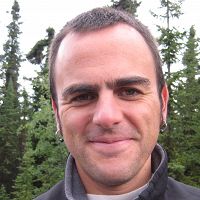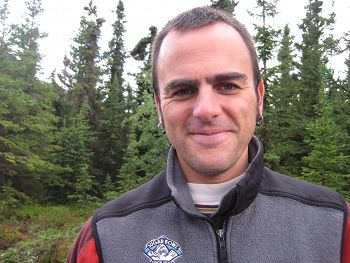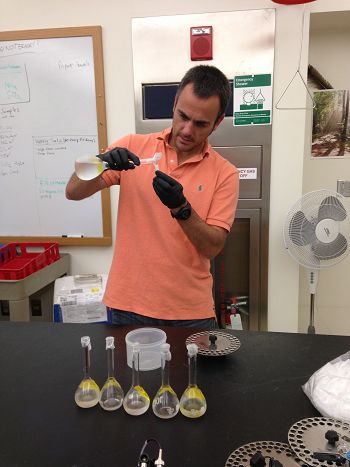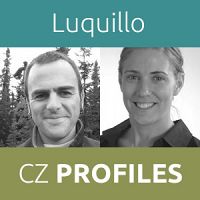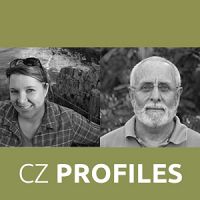Critical Zone Profile - ADAM WYMORE (freshwater ecologist, post-doctoral researcher)
Adam Wymore is an ecologist who studies how energy and nutrients move through the environment, especially into and through freshwater ecosystems. Adam is particularly interested in how different types of organic matter (that is, carbon-based molecules) react during their downstream export. Adam’s research looks at something scientists currently know very little about: how the molecular composition of carbon molecules determines their fate within the environment.
For example, some types of carbon molecules are used by aquatic microbial communities to build new biomass and enter the food web, other types are respired off as carbon dioxide (CO2), while still other types of carbon molecules are exported downstream to the oceans. What happens to the different types of carbon molecules also impacts how other essential nutrients are processed and what types of organisms (from microbes to fish) live in our streams. The research being done by ecologists like Adam is critical to understanding how carbon molecules react and interact with the environment—and can ultimately help to inform management of our freshwater ecosystems and water quality protection.
“Critical Zone science helps to promote ‘systems-thinking’ for our future scientists, community members, politicians, and voters.” - Adam Wymore
I am originally from the Boston area, but I also spent many years in the Midwest in Urbana, Illinois, and in the mountains near Albuquerque, New Mexico. I completed my BA in Biology at Earlham College in Richmond, Indiana, my MS in Biology at California State University in Sacramento, California, and my PhD in Freshwater Ecology at Northern Arizona University in Flagstaff, Arizona. I think this variety of places and experiences helped me form an awareness of how incredibly diverse and dynamic environments can be.
As I look back on places I have lived and worked, I see that many changes have occurred in my lifetime. As a kid in New Mexico, I remember considerable snow pack at the higher elevations where we lived, a consistent and predictable summer monsoon, and plenty of water in the rivers for exciting whitewater canoeing. These patterns no longer occur with the same frequency or magnitude. Spending time in California also let me witness first-hand how we manipulate the environment, especially water resources. My years living in California along the banks of the American River were formative in my development as a freshwater ecologist.
Quebrada Toranja is one of the many streams draining the Luquillio Mountains and the Luquillo Critical Zone Observatory in Puerto Rico.
I came to work with the Luquillo Critical Zone Observatory in Puerto Rico, once I saw how my research would benefit from a critical zone framework. CZ science views the environment as a vertical yet interacting system from the bedrock through the soil and up into the canopy of the vegetation. Critical zone scientists consider multiple potential factors (such as dominant bedrock, soils, and vegetation) that may affect their particular study system. Regardless of the study system, we must consider inputs from below, above, uphill, upstream, biotic, abiotic, etc.
For example, streams receive large inputs of nutrients from the landscape. Agriculture and urbanization add large quantities of nitrogen and phosphorous to aquatic ecosystems, which can result in “dead zones” in downstream receiving waters. However, the microbial process of denitrification can remove excess nitrogen from streams before they enter downstream receiving waters, where the nitrogen might have serious deleterious effects and cause dead zones. Denitrification is a reaction that involves both nitrate (often the form of nitrogen that enters freshwater ecosystems) and dissolved forms of carbon. Understanding how these elements interact is thus critical to keeping our freshwater ecosystems functioning and healthy. To better manage our freshwater resources, we need to understand that streams are part of an interacting system that is very sensitive to inputs and disturbances from outside.
“When it comes to creating wise management plans for our natural resources, we must consider as many interacting factors as possible to preserve the quality of our soils and water.”
A CZ perspective helps one to consider all of the potential interacting factors that may influence a study system. By using a series of ecosystems across Critical Zone Observatories, scientists like me can conduct identical experiments at different sites. For example, streams at different CZOs have different concentrations of dissolved organic carbon. These streams also vary in lithology (i.e., bedrock), dominant vegetation, upstream water sources, soil carbon stocks, and climate (e.g., temperate vs. tropical).The multi-disciplinary, cross-site perspective that critical zone science fosters ultimately provides a more holistic view of the interactions that effect elemental cycling and life processes within different streams—and within different ecosystems.
Pouring stream water samples to measure PO4 (phosphate) at the University of New Hampshire's Water Quality Analysis Lab.
The CZO network has been highly valuable to me. In addition to increasingly the breadth of my professional network, it has also increased my interdisciplinary network with other researchers who are interested in working across traditional Earth science boundaries. There is a strong cohort of early career CZ scientists who frequently come together to work on ideas, projects, papers, and proposals. This early career cohort is particularly interested in the development of cross-site CZ research, which will help to broaden the impact of critical zone science in the coming years.
I think it would be interesting to consider the creation of a Critical Zone Science graduate program at a particular university, perhaps affiliated with a Professional Science Master’s Program. Making CZ science into a “formal” discipline would definitely help drive CZ science to greater national recognition.
:: By Linda Copman, staff writer ::
Adam Wymore, Post-Doctoral Researcher
Quebrada Toranja is one of the many streams draining the Luquillio Mountains and the Luquillo Critical Zone Observatory in Puerto Rico.
Pouring stream water samples to measure PO4 (phosphate) at the University of New Hampshire's Water Quality Analysis Lab.
Related News
Explore Further
